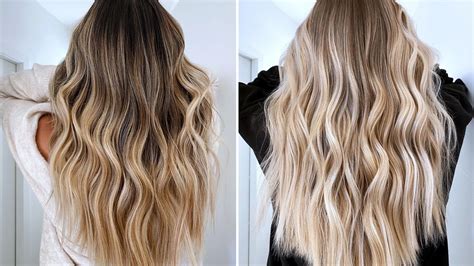Introduction

Balayage and highlights are two popular hair color techniques that can enhance your natural hair color or create a more dramatic transformation. While both techniques involve lightening strands of hair, they differ in their application, results, and maintenance. This guide will explore the nuances of balayage and highlights, helping you make an informed decision for your next hair color update.
Defining Balayage and Highlights
Balayage (pronounced “bah-lee-ahge”) is a freehand painting technique where color is swept onto the hair in a natural, graduated way. This creates soft, subtle transitions and a sun-kissed, effortless look.
Highlights are individual strands of hair that are lightened using foils or a highlighting cap. They typically result in a more defined, contrasting effect than balayage.
Choosing the Right Technique for Your Hair
The best hair color technique for you will depend on your specific hair texture, color, and desired results.
-
Balayage is ideal for:
- Creating a natural, sun-kissed look
- Enhancing existing hair color
- Adding depth and dimension
-
Highlights are suitable for:
- Creating a bolder, more dramatic effect
- Lightening darker hair
- Adding a pop of color
Key Differences Between Balayage and Highlights
| Feature | Balayage | Highlights |
|---|---|---|
| Application | Freehand painting | Foils or cap |
| Result | Graduated, natural transitions | Defined, contrasting strands |
| Maintenance | Lower maintenance, touch-ups every 3-4 months | Higher maintenance, touch-ups every 6-8 weeks |
| Cost | Typically more expensive | Typically less expensive |
Benefits of Balayage
- Creates a natural, sun-kissed look
- Adds depth and dimension to hair
- Low maintenance, requiring less frequent touch-ups
- Less damaging to hair than traditional highlights
Benefits of Highlights
- Creates a bolder, more dramatic effect
- Can lighten darker hair more effectively
- Can be customized to create a variety of looks
- More affordable than balayage
Common Mistakes to Avoid
- Over-processing: Avoid leaving the bleach on your hair for too long, as this can damage the hair.
- Uneven application: Ensure that the color is applied evenly throughout the hair to prevent patchy results.
- Improper maintenance: Touch up your color regularly to maintain the desired effect and prevent fading.
Expert Perspectives
“Balayage offers a more natural, lived-in look,” says hair stylist Stephanie Brown. “It’s perfect for creating that effortless, beachy vibe.”
“Highlights can be a great way to add a pop of color or create a more dramatic transformation,” adds hair colorist David Jones. “They’re particularly effective on darker hair.”
Conclusion
Balayage and highlights are both excellent hair color techniques that can enhance your natural hair or create a more dramatic look. By understanding the differences between these techniques and choosing the one that best suits your hair and desired results, you can achieve a stunning hair color transformation that will leave you feeling confident and radiant.
